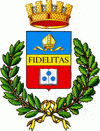Soriano nel Cimino (Soriano nel Cimino)
 |
The town is overlooked by Monte Cimino, the highest peak in the Monti Cimini.
* The Orsini Castle, built by Orso Orsini in the 13th century. It was the summer residence of Pope Nicholas III, uncle of Orso. It was a high security castle until the 1990s and is now managed by the Tuscia University.
* The Palazzo Chigi-Albani (16th century), designed by Ottaviano Schiratti. The interior houses the Papacqua Fountain.
* The small Romanesque church of San Giorgio (11th century).
* Cathedral (Duomo), of San Nicola di Bari from 1794.
* Church of Sant'Eutizio.
* Fontana Vecchia ("Old Fountain"), built in the 15th century.
* Porta Romana ("Roman Gate"), a copy of the Porta Pia in Rome.
* SUBLIMAZIONE (Urban Sculpture), a permanent installation by Giorgio Capogrossi (Montez) - Piazzale Cavalieri di Vittorio Veneto
Map - Soriano nel Cimino (Soriano nel Cimino)
Map
Country - Italy
 |
 |
| Flag of Italy | |
Italy was the native place of many civilizations such as the Italic peoples and the Etruscans, while due to its central geographic location in Southern Europe and the Mediterranean, the country has also historically been home to myriad peoples and cultures, who immigrated to the peninsula throughout history. The Latins, native of central Italy, formed the Roman Kingdom in the 8th century BC, which eventually became a republic with a government of the Senate and the People. The Roman Republic initially conquered and assimilated its neighbours on the Italian peninsula, eventually expanding and conquering a large part of Europe, North Africa and Western Asia. By the first century BC, the Roman Empire emerged as the dominant power in the Mediterranean Basin and became a leading cultural, political and religious centre, inaugurating the Pax Romana, a period of more than 200 years during which Italy's law, technology, economy, art, and literature developed.
Currency / Language
| ISO | Currency | Symbol | Significant figures |
|---|---|---|---|
| EUR | Euro | € | 2 |
| ISO | Language |
|---|---|
| CA | Catalan language |
| CO | Corsican language |
| FR | French language |
| DE | German language |
| IT | Italian language |
| SC | Sardinian language |
| SL | Slovene language |















